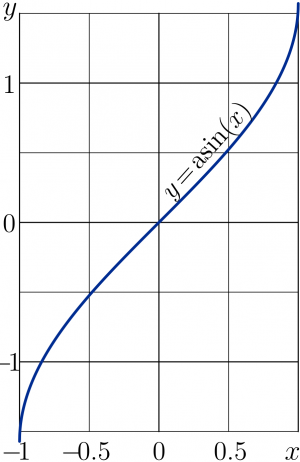ArcSin

ArcSin, or asign, or arcsin is holomorphic function, inverse of sin;
- $\displaystyle \sin(z) = \frac{\exp(\mathrm i z)- \exp(-\mathrm i z)}{2~ \mathrm i}$
$f=\arcsin(z)$ is holomorphic solution $f$ of equation
- $ \sin(f)=z$
such that $\arcsin(0)\!=\!0$.
ArcSin is considered as elementary function, more specifically Inverse trigonometric function
Range of holomorphism
$\arcsin(z)$ is holomorphic in the whole complex plane except the halflines $z\!\le\! -1$ and $z\!\ge\! 1$.
Complex map or $f=\arcsin(x+\mathrm i y)$ is shown in figure at right in the $x$, $y$ plane with levels $u=\Re(f)=\mathrm{const}$ and levels $v=\Im(f)=\mathrm{const}$. Thick lines correspond to the Integer values. The cut lines are shown with dashed lines. In vicinity of the cut lines, the real part of ArcSin approach values $\pm \pi/2$.
Symmetry
ArcSin is even function: $: \arcsin(-z)=-\arcsin(z)$
Real values
While $-1\le x\le 1$, id est, along the real axis, $\arcsin(x)$ has real values. The graphic is plotted in figure at right.
In particular,
- $ \displaystyle \arcsin(0)=0$
- $ \displaystyle \arcsin\left(\frac{1}{2}\right)=\frac{\pi}{6}$
- $ \displaystyle \arcsin\left(\frac{1}{\sqrt{2}}\right)=\frac{\pi}{4}$
- $ \displaystyle \arcsin\left(\frac{\sqrt{3}}{2}\right)=\frac{\pi}{3}$
- $ \displaystyle \arcsin\left(1\right)=\frac{\pi}{2}$
Numerical Implementation of ArcSin
In some programing languages, acos is implemented only for real argument. However, it can be expressed through the log function as follows:
complex double asin(complex double z){
if(Im(z)<0){if(Re(z)>=0){return M_PI/2.-I*log( z + sqrt(z*z-1.) );}
else{return M_PI/2.-I*log( z - sqrt(z*z-1.) );}}
if(Re(z)>=0){return M_PI/2.+I*log( z + sqrt(z*z-1.) );}
else {return M_PI/2.+I*log( z - sqrt(z*z-1.) );} }
where I denotes the imaginary unity; Re and Im denote the real and imaginary parts; M_PI denotes $\pi$.
Fortunately, in the C++ compilers, function log is already implemented for complex double argument.
This implementation above used to plot the complex map of ArcSin at the top figure. In particular, the same representation can be used for real values of the argument; the explicit plot of ArcSin is generated with the same representation. (Click the figure to see the code used for its generation.) However, the last graphic could be generated also with the internal C++ function asin of real argument, as well as with flipping of plot of function sin.
Integral representaitons
- $ \displaystyle \!\!\!\!\!\!\!\!\!
\arcsin(z)=\int_0^z \frac{\mathrm d t}{\sqrt{1-t^2}}$
The appropriate contour of integration may go straight from zero to $z$.
Relations to other functions
$ \arcsin(z)= - \mathrm i ~\mathrm{arcsinh}( \mathrm i z)$
where arcsinh=ArcSinh is inverse function of Sinh;
- $ \displaystyle
\sinh(z)=\frac{\exp(z)+\exp(-z)}{2}$
ArcSinh also can be expressed through ArcSin,
- $ \mathrm{arcsinh}(z)= \mathrm i ~ \arcsin( \mathrm i z)$
Also, ArcSin can be expressed through function arccos=ArcCos:
- $ \displaystyle
\arcsin(z) = \frac{\pi}{2} - \arccos(z)$
and correspondently,
- $ \displaystyle
\arccos(z) = \frac{\pi}{2} - \arcsin(z)$
Expansions
Expansion at zero
Often, the expansions of Sin and ArcSin at small values of argument are used;
- $ \displaystyle \!\!\!\!\!\!\!\!\!
\sin(z)=z -\frac{z^3}{3!} +\frac{z^5}{5!} -\frac{z^7}{7!} +... $
- $ \displaystyle \!\!\!\!\!\!\!\!\!
\arcsin(z)=z +\frac{z^3}{3!} +\frac{3z^5}{40} +\frac{5z^7}{112} +... $
Mathematica allows to evaluate many terms of this expantion:
- $ \displaystyle \!\!\!\!\!\!\!\!\!
\arcsin(z) = z+0.166666666666667
z^3$ $+0.0750000000000000
z^5$ $+0.0446428571428571
z^7$ $+0.0303819444444444
z^9$ $+0.0223721590909091
z^{11}$ $+0.0173527644230769
z^{13}$ $+0.0139648437500000
z^{15}$ $+0.0115518008961397
z^{17}$ $+0.00976160952919408
z^{19}$ $+0.00839033580961682
z^{21}$ $+0.00731252587359885
z^{23}$ $+0.00644721031188965
z^{25}$ $+.. $
Expansion in vicinity of the branchpoints
Extremums of function Sin correspond to branch points of ArcSin. The expansions can be written as follows:
- $ \displaystyle \!\!\!\!\!\!\!\!\!
\sin\left( - \frac{\pi}{2}+t\right) = -1+ \frac{t^2}{2}-\frac{t^4}{24}+\frac{t^6}{720}-\frac{t^8}{40320}+..$
- $ \displaystyle \!\!\!\!\!\!\!\!\!
\arcsin(-1+t) = -\frac{\pi}{2}+\sqrt{2\,t} +\frac{t^{3/2}}{6\sqrt{2}}+\frac{ 5~ t^{5/2}}{80 \sqrt{2}}+ .. $
Mathematica allows to evaluate many of terms of this expansion;
- $ \displaystyle \!\!\!\!\!\!\!\!\!
\arcsin(-1+t) =- 1.5707963267948966 $ $+ \sqrt{t} ~ \Big($ $ 1.4142135623730950 $ $ +0.117851130 19775792
t$ $ +0.026516504294495532
t^2$ $+0.0078918167543141465
t^3$ $+0.0026854098677874526
t^4$ $+0.00098871908768538028
t^5$ $+0.00038344554362157376
t^6$ $+0.00015429118302868087
t^7$ $+0.000063815287098259552
t^8$ $+0.000026962891771048261
t^9$ $+0.000011587623725414788
t^{10}$ $
+0.0000050495474929920175 t^{11} $ $ +0.0000022260088531606476 t^{12} +... \Big)$
Similar expansion of ArcSin can be written at another branch point:
- $\arcsin(1-t) =-\arcsin(-1+t) $
The expansions above allow to evaluate ArcSin at least in vicinity of the segment $[-1,1]$; the precision of evaluation $s_0\approx \arcsin(z)$ can be improved with the iteration
- $ \displaystyle
s_{n+1}=s_n+\frac{z-\sin(s_n)}{\sin'(s_n)}=s_n+\frac{z-\sin(s_n)}{\cos(s_n)} $
Keywords
sin, cos, Sinh, ArcSinh, ArcCos, elementary function, inverse function, Inverse trigonometric function, complex map, C++
